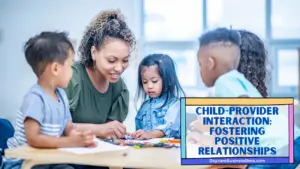Choosing the best daycare for your child is a huge decision that will have a huge impact on their growth, development, and general well-being. How do you know which home daycare meets your child’s requirements and expectations in a sea of options? The answer might be found in a valuable tool: the home daycare interview checklist. This checklist gives parents the ability to go deeper, evaluate key issues, and make an informed decision beyond the surface-level tour and early impressions.
The most useful home daycare interview checklist includes licensing & certification, safety measures, daily routine, child-provider interaction, and parent references. These components ensure a comprehensive assessment of the daycare’s suitability and quality of care.
Licensing & Certification: A Solid Foundation

The fundamental foundation of proper licensing and certification is at the heart of every reputable home daycare. These priceless documents provide unwavering confidence that the daycare provider strictly adheres to the key regulatory criteria and rigorous guidelines established by the relevant authorities. Delving into the domain of licensing and certification is a smart step to take when commencing the process of picking an appropriate daycare for your precious little ones.
It is critical to participate in a serious discourse about potential daycare providers’ license status while evaluating them. This conversation should continue with the upcoming request for copies of the necessary certifications. A thorough investigation not only allows for the smooth operation of a legal and compliant daycare center, but it also instills confidence in the provider that they are deeply committed to maintaining an exceptional level of professionalism and unwavering dedication to nurturing the children in their care.
Parents and guardians can ensure that their children are in a safe and caring environment by carefully reviewing the documentation that substantiates a childcare provider’s compliance with licensing requirements. These licenses and certifications serve as a symbol of the daycare provider’s commitment to creating an environment in which early development thrives beneath the protective canopy of set regulations.
Read more about Zero-Cost Daycare Startup: Strategies for a Thrifty Daycare Launch
Safety Measures: Creating a Secure Environment
The importance of child protection remains unrivaled in elevating the welfare of children to an illustrious pedestal. Safety measures emerge as an essential feature of the thorough daycare interview checklist inside the intricate mosaic of analyzing potential daycare choices. Inquisitive parents are tasked with diving into the area of safety standards that resolutely protect the sanctuary of these young minds.
Parents are encouraged to start a conversation about the daycare’s safety framework because they want their children to grow up in a safe environment. Inquiries about the meticulous childproofing procedures implemented within the facility should be prioritized. Parents can determine whether the daycare is ready to decrease risks and improve child safety by assessing the extent to which the environment has been tailored to reduce potential hazards.
The inclusion of well-structured emergency plans is an important strand in this rich safety tapestry. Sifting through the daycare’s readiness to deal with unexpected situations through systematic emergency protocols provides great information into their overall preparedness. An investigation into first aid training is also critical. Uncovering the extent to which staff members are trained in providing emergency care adds to the certainty that the daycare’s protective umbrella is built on a strong basis.
A watchful examination for hiding threats becomes necessary when discerning eyes sweep over the physical breadth of the daycare. The rigorous identification and correction of potential hazards demonstrate the daycare’s dedication to ensconce its charges in a safe cocoon. This visual examination is bolstered by the need to validate the daycare’s adherence to safety rules. This two-pronged effort, which includes both observation and confirmation, combines to create a profound sensation of calm, supporting the assumption that a child’s stay in this sanctuary will be marked by an impenetrable shield of protection.
Daily Routine: Nurturing Structure and Consistency
Children, like delicate blossoms, blossom most profoundly under the embrace of structure and routine. The resonance of a well-orchestrated daily routine within a daycare setting plays a pivotal part in the symphony of early childhood development. The interview procedure, in which parents are granted the pleasure of unraveling the composition of the daycare’s daily cadence, emphasizes the quest for an optimal atmosphere in which a child’s growth blooms like a symphony.
Inquisitive parents set out on a journey of exploration, hoping to gain insight into the rhythms that govern their children’s days. This rhythmic revelation involves several critical aspects, the most important of which is the tapestry of activities woven into the everyday fabric. These activities, whether instructive, creative, or playful, provide the foundation of the child’s cognitive, emotional, and physical development. As a result, parents can direct their inquiries toward this critical canvas, gleaning information on the nature, diversity, and frequency of these activities.
Aside from the notes of involvement, the intervals of sustenance and repose are key movements in our daily symphony. The ebb and flow of food and nap times reflect not only a temporal cycle but also an acceptance of holistic care. Understanding the harmony that runs through these intervals reveals the daycare’s commitment to the physical well-being of the child. This understanding also gives parents insight into how their child’s biological cycles may interact with the daycare’s routine.
The interplay of play, learning, and rest takes on the role of a prominent motif in the vast theater of balanced growth. This harmonic trio serves as a barometer of the daycare’s capacity to provide an atmosphere that meets the changing requirements of a kid. Armed with this knowledge, parents may choose whether the tempo of the daycare mirrors their child’s rhythms and integrates neatly with their family pattern.
Child-Provider Interaction: Fostering Positive Relationships

The delicate dance between daycare workers and children is woven into the very fabric of emotional and cognitive maturity. Parents are exposed to an observing position, attuned to the intricacies of these relationships, as they navigate the complicated ballet of picking the appropriate daycare. The mechanics of involvement take center stage in this field of study, their significance resonating as profoundly as a heartbeat.
The keen eye focuses on the arrangement of moments between caregivers and children as the interview progresses. Warmth emerges as a vital ingredient in this theater of connection. A loving environment, marked by a real liking for the children, is a hallmark of a childcare provider’s effectiveness. Attentiveness, like a careful conductor, represents a provider’s devotion to tending to each child’s particular requirements, sowing the seeds of trust and emotional security.
The ability of a provider to hear the symphony of children’s voices has far-reaching repercussions. Active listening, which is similar to harmonizing with the many tones of a choir, indicates a supportive environment for children’s opinions. Open communication, like a resounding chorus, allows children to freely express their thoughts and emotions, establishing a rich basis for their cognitive development.
The connection fostered between caregivers and children resonates as a vital chord in the symposium of trust and security. Parents understand the crucial significance that a provider plays in their child’s life, similar to a mentor on the developmental journey. This symbiotic relationship boosts children’s self-assurance and belief in the world around them, laying the groundwork for their emotional and social development.
This interview’s overture also extends to the realms of punishment and dispute resolution, defining the line where parenting principles meet caregiving methods. Queries that delve into this territory not only reveal a provider’s technique but also establish the framework for a fruitful collaboration. Aligning these principles facilitates a smooth transfer from the daycare setting to the child’s home, promoting consistency and eliminating potential confusion.
Read more about Unmasking Daycare Industry Dynamics: The Market Analysis Advantage
Parent References: Insights from Those Who Know Best
Within the context of choosing the best daycare, the interview serves as a glance into the atmosphere, a snapshot of what may lie ahead. However, navigating this complex decision-making process benefits greatly from the advice of individuals who have already traveled a similar path. Parents are invited to grasp the power of references in this symphony of ideas, transforming this trip into a joint endeavor.
The path to priceless illumination begins with a simple request: a list of references, a collection of voices that resonate with firsthand experience. This compilation serves as a compass, helping parents through the maze of options. Armed with these contact points, parents begin on an inquisitive journey, reaching out to these historical navigators and gaining their experiences, views, and viewpoints.
The canvas of experience broadens as a result of these conversations. Parents ask questions that go beyond the surface, delving into the very soul of childcare. In these anecdotes, the level of care, like an artist’s brushstrokes, comes to life. The stories of nurturing, safety, and participation offer a vivid picture of the influence of daycare on young lives.
Communication, like the threads of a tapestry, emerges as a key motif. Parents gain knowledge of the provider’s accessibility, responsiveness, and information flow channels. This aspect is an essential component of the daycare experience, influencing not only the parents’ sense of connection but also the child’s sensation of being held inside a supporting network.
Recognizing issues and obstacles does more than cast shadows; it lights the path ahead. The stories given by those who have gone before us provide a window into the aspects of daycare that may need to be improved. These discoveries, like the chisel of a sculptor, contribute to the daycare’s constant evolution and progress.
Comprehensive Assessment: Piecing Together the Puzzle
The home daycare interview checklist, like a mosaic of concerns, combines to form a potent tool that enables parents to embark on their childcare journey with clarity and discernment. This checklist is more than simply a list of bullet points; it’s an interwoven tapestry in which each strand contributes to the greater design of quality treatment and holistic growth.
The pillars of license and certification provide the foundation of legality and professionalism. These documents serve as the foundation, confirming that the daycare is not only functioning within legal limitations but also meeting the necessary criteria set by authorities. This strong foundation lays the groundwork for a dependable, compliant, and structured childcare environment.
Daycare safety precautions, like protective barriers, ring the child’s experience. These protocols serve as sentinels, ensuring that the physical space is protected from any threats. This reinforced environment is critical because it gives a blank canvas for children’s curiosity, exploration, and learning to grow without being hampered by unneeded dangers.
The cadence of the daily routine serves as a backdrop for a child’s developmental symphony. This routine establishes a pattern for exploration, play, education, and rest. It’s a stage in which every aspect of the day works together to orchestrate the child’s development path.
A positive child-provider relationship emanates warmth and security. Caregivers’ genuine relationships and attentive engagements with children foster a sense of trust, emotional connectedness, and self-confidence. This relationship not only serves as the foundation for a child’s emotional growth, but it also serves as the foundation for meaningful learning experiences.
Parental references, the threads that connect everything, provide a real-world perspective on the daycare’s performance. These stories serve as a compass, guiding parents with advice from others who have gone before them. These references integrate abstract factors such as licensing, safety, routine, and interactions into a concrete narrative of what parents might expect, anchoring their decision-making process with lived experiences.
Frequently Asked Questions

What is the significance of licensing and certification in a home daycare?
Licensing and certification are essential in a home daycare setting because they verify that the provider complies with regulatory obligations as well as industry standards. Verified licensing shows that the daycare follows safety requirements, educational standards, and health recommendations. It also gives parents trust that the daycare operates inside a structured framework, which improves overall care quality.
What effect do safety measures have on the daycare environment?
Safety measures are critical in providing a safe and caring environment for children. A well-prepared daycare should have extensive safety practices in place, such as childproofing, emergency planning, and first aid training. These safeguards not only protect children from potential dangers but also demonstrate the childcare provider’s dedication to their well-being. Prioritizing safety develops trust between parents and caregivers and ensures that children can safely explore, learn, and play.
What is the significance of child-provider contact in a daycare setting?
The interaction between a kid and his or her caregiver has a substantial impact on the child’s emotional, social, and cognitive development. Positive interactions foster the development of solid relationships, trust, and communication skills. Children feel safe and supported when a caregiver engages them warmly, listens attentively, and responds properly. This dynamic must be evaluated during the childcare interview to guarantee that your child will receive the caring attention required to thrive in the daycare environment.
To learn more on how to start your own daycare checkout my startup documents here.
The information provided by DaycareBusinessBoss.com (“The Site”) is for general informational purposes only. All information on the Site is provided in good faith, however, we make no representation or warranty of any kind, express or implied, regarding the accuracy, adequacy, validity, reliability, availability or completeness of any information on the Site. Under no circumstance shall we have any liability to you for any loss or damage of any kind incurred as a result of the use of the Site or Reliance on any information provided on the Site. Your use of the Site and your reliance on any information on the Site is solely at your own risk.
This blog post is for educational purposes only and does not constitute legal advice. Please consult a legal expert to address your specific needs. Terms and Conditions. (https://daycarebusinessboss.com/terms-conditions/)

Meet Shawn Chun: Entrepreneur and Childcare Business Fan.
I’m a happy individual who happens to be an entrepreneur. I have owned several types of businesses in my life from a coffee shop to an import and export business to an online review business plus a few more and now I create online daycare business resources for those interested in starting new ventures. It’s demanding work but I love it. I do it for those passionate about their business and their goals. That’s why when I meet a childcare business owner, I see myself. I know how hard the struggle is to retain clients, find good employees and keep the business growing all while trying to stay competitive.
That’s why I created Daycare Business Boss: I want to help childcare business owners like you build a thriving business that brings you endless joy and supports your ideal lifestyle.

